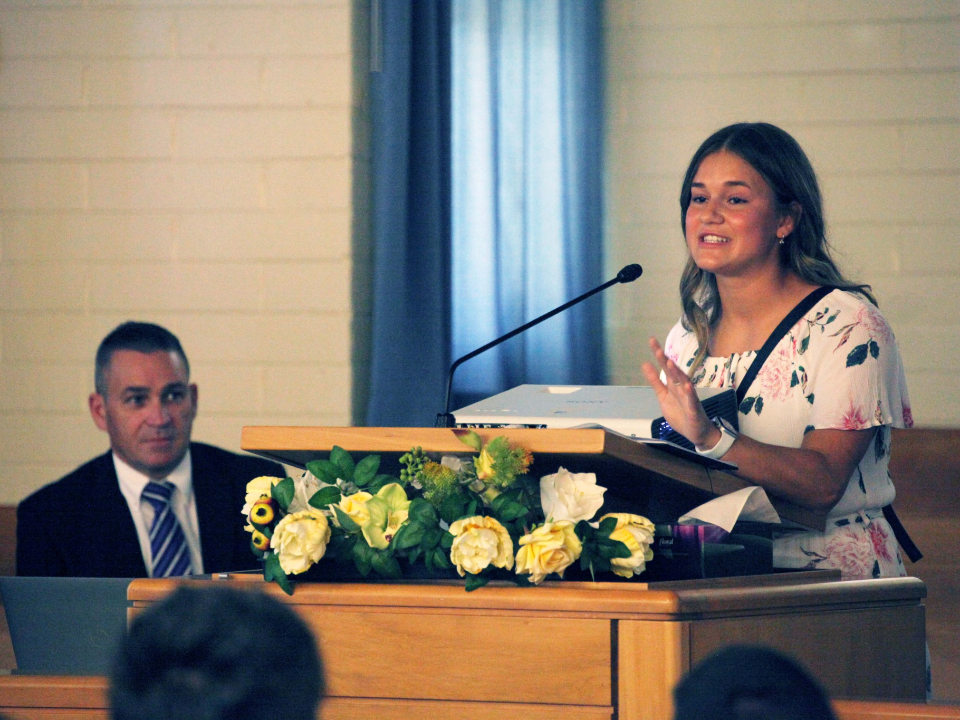In this message, Elder Ian S. Ardern, Pacific Area President of The Church of Jesus Christ of Latter-day Saints, writes of testimony sharing.
The first Sunday of each month is normally reserved for what we call "fast and testimony meeting." It was a pleasure to be in the Takapuna Ward today [in Auckland, New Zealand] to listen to members testify of Christ as their Redeemer and of the Book of Mormon as another witness of Christ. It was equally edifying to hear them share their witness of Joseph Smith as the prophet of the restoration and of President Nelson as our living prophet. It is very important to not only be grateful for these truths but also to testify of them.

A-member-of-a-young-adult-congregation-in-Auckland-expresses-her-thoughts.-New-Zealand,-February-2021
A member of a congregation in Auckland shares her feelings about the restored gospel of Jesus Christ.© 2021 by Intellectual Reserve, Inc. All rights reserved.A precedent for formal testimony bearing in the Church was set at the dedication of the Kirtland Temple in 1836. On that occasion several people stood and spoke of the things they had seen and felt. Thereafter, in Kirtland, it was customary to hold fast meetings on Thursday afternoons, although other days of the week were sometimes used in other areas where the Saints gathered.
From time to time during his presidency, President Brigham Young reiterated the importance of fast day as a means of supporting the poor through donations. This inspired practice continues and blesses the lives of many, including the givers. As an Area Presidency, we are grateful for the fast offering donations made by so many to help others. I have often thought that these donations are a manifestation of the desire of members to keep the second great commandment to love thy neighbour. We thank you and assure you that the funds are wisely used to assist those in need.
Toward the end of the nineteenth century, economic changes in the working world made it difficult to attend a daytime Thursday fast meeting. In 1896 Hyrum M. Smith, then a missionary in England, wrote to his father, President Joseph F. Smith, then second counselor in the First Presidency, about the difficulty members faced getting excused from their jobs to attend Thursday fast meetings. Workers had no paid leave, and “when these came from the pits, they had to go home, bathe, and change their clothes” (see Joseph Fielding Smith, “Prayer and Fasting,” Improvement Era, Dec. 1956, 895). Additionally, you can imagine just how difficult it would be to do hard manual labour without food or drink. He therefore asked if Sunday would be a more appropriate day.
The First Presidency and Quorum of the Twelve prayerfully discussed the question and felt guided to change fast meeting to the first Sunday of each month. In announcing the change, President Wilford Woodruff and his counselors said they recognized the need to make the meeting more accessible to all members throughout the world. The change became effective on 6 December 1896 and the first Sunday of the month has been used ever since.
In a First Presidency letter dated 14 February, 2013, they noted:
“In the past the First Presidency has expressed concern that in some instances, members who desire to bear their testimonies in fast and testimony meeting do not have the opportunity to do so. Bishoprics are again encouraged to help all people learn to express a brief, heartfelt testimony of our Father in Heaven and His Son, Jesus Christ, and the truths of the restored gospel so that more members may have the opportunity to participate.”
I know that as I testify of gospel truths, my own testimony is strengthened. I therefore encourage our members ─ especially our young men and women and young single adults ─ to share their testimonies; for I know, all will be edified.
Sincerely,
Elder Ardern